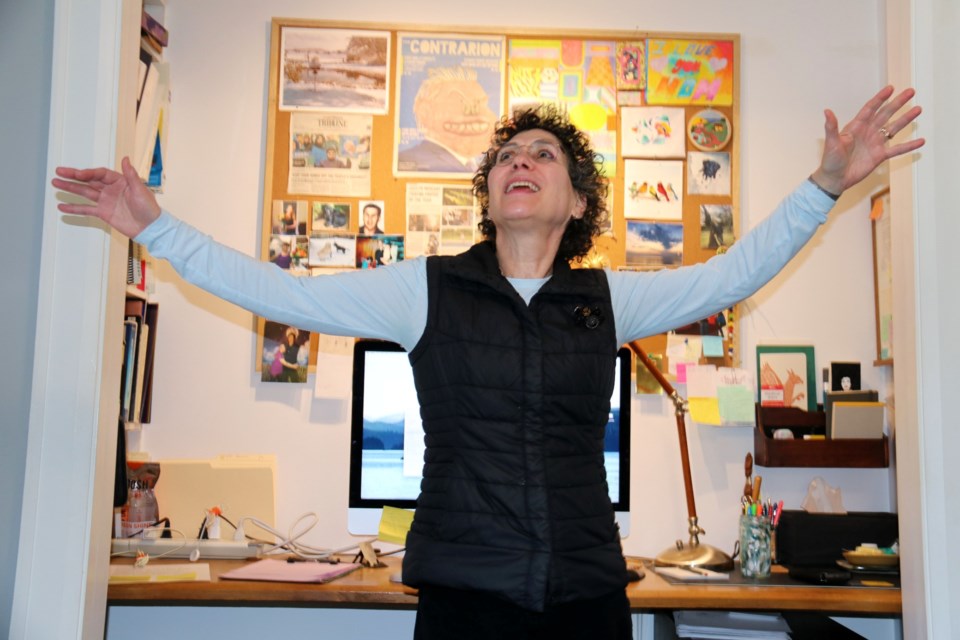A new class is coming to the University of Guelph this fall, offering students a unique chance to learn how people with movement disorders can manage symptoms with mime and circus techniques.
The experiential learning class, dubbed Mime over Mind, will consist of workshops focused on the connection between the arts and treating movement disorders like Parkinson’s disease (PD) or multiple sclerosis.
Workshops will be led by Barbara Salsberg Mathews, who was diagnosed with Parkinson's in 2020 and has been using mime and circus techniques to manage her symptoms, like tremors and facial masking.
Trained in experimental mime and with a master’s in education, Salsberg Mathews will be teaching the workshops alongside Rebecca Barnstaple, a neuroscientist and dance scholar who’s used improv and dance to treat Parkinson's. Professor’s Kimberly Francis and Sally Hickson are the instructors for the course.
“Barbara … has facilitated these kinds of workshops with people with Parkinson's already. And so we're coming in to help her capture proof that this is working, beyond just anecdotal,” Francis said.
“We wanted to do something that could be bigger than just her in a room with a video camera doing these techniques. So we thought, what if this were an experiential learning opportunity for students?”
Parkinson's affects 10 million people, with 30 per cent under the age of 60, Salsberg Mathews said. There is no cure, which is why Francis said it’s so important for techniques and research like this.
“It’s a rapidly growing disease, and we need tools. We need to explore all possibilities,” she said.
On top of becoming “fluent in mime,” as Francis put it, students will learn how to really understand and connect with body movement. There will also be readings on how to merge the arts with scientific and medical research, and students will be taught how to construct a research project, she said.
Salsberg Mathews will walk students through and demonstrate the six principles of Parkinsons, developed originally by Rob Mermin: awareness, observation, analysis, visualize, mime and real life.
For example, when she became aware she couldn’t pick up a glass of water without spilling it, she observed how she was holding it. Next she analyzed what’s involved in picking up a glass of water normally, and visualized doing it. Then she would mime it before practicing with an actual glass.
This is then practiced repeatedly, creating motor memory.
“That helps them really get connected to what's going on in their body. It's pretty magical, what happens. You become very conscious, and override some of these lousy annoying symptoms.” she said.
“Most importantly, it's a lot of fun,” she said, adding that the classes are always a safe atmosphere full of laughter.
Salsberg Mathews said it’s important for the students to know how to apply the techniques to themselves, so they can better teach it to people with movement disorders.
“I'm really looking forward to students just exploring their body motion, knowing how to move and gaining a better appreciation for what that can do,” said Francis.
Students who successfully complete the course will be eligible to participate in the research project, which will begin in the winter semester, led by Barnstaple and Hickson.
The research project will focus on people who are in the earlier stages of Parkinson's or other movement disorders, since the techniques are intended to manage symptoms, she said.
For example, people just beginning to have balance issues or a tremor.
“If you start with more people who are (in) early stages, they often tend to also have the most benefit,” she said. “So you retrain the brain early on. And you give them some good techniques and methods to apply daily, mindfully. And that helps to create a new neural pathway that hopefully sticks.”
“It's the best kind of work, you get to be creative. And you get to help people and you get to potentially add something to the world, that could be really helpful,” Francis said.
Currently the course is categorized under the humanities. If it continues beyond this fall, it will likely become part of the new bachelor of arts, health and sciences program currently being developed.
It’s a smaller class, with just 20 spots, and starts Sept. 13. Anyone at the university is welcome to take it, though it’s targeted specifically for students interested in fields like art therapy.
“Ultimately, we're honouring (Salsberg Mathews’s) legacy and providing her the opportunity to pay it forward. It's a once in a lifetime opportunity,” Francis said.
For Salsberg Mathews, it’s a dream come true.
“It's (all about) giving back at this stage in my life. What can I leave behind? Something that is a shade more beautiful, hopefully, that will improve the day to day quality life of my PD sisters and brothers. And that makes me very happy,” she said.
